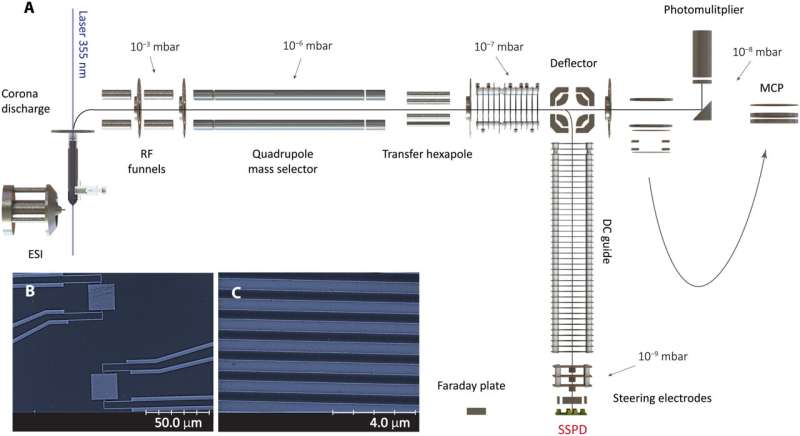This article has been reviewed according to Science X's editorial process and policies. Editors have highlighted the following attributes while ensuring the content's credibility:
fact-checked
peer-reviewed publication
trusted source
proofread
Superconducting nanowires detect single protein ions

An international research team led by quantum physicist Markus Arndt (University of Vienna) has achieved a breakthrough in the detection of protein ions: Due to their high energy sensitivity, superconducting nanowire detectors achieve almost 100% quantum efficiency and exceed the detection efficiency of conventional ion detectors at low energies by a factor of up to a 1,000.
In contrast to conventional detectors, they can also distinguish macromolecules by their impact energy. This allows for more sensitive detection of proteins and it provides additional information in mass spectrometry. The results of this study were recently published in the journal Science Advances.
The detection, identification, and analysis of macromolecules is interesting in many areas of life sciences, including protein research, diagnostics, and analytics. Mass spectrometry is often used as a detection system—a method that typically separates charged particles (ions) according to their mass-to-charge ratio and measures the intensity of the signals generated by a detector. This provides information about the relative abundance of the different types of ions and therefore the composition of the sample.
However, conventional detectors have only been able to achieve high detection efficiency and spatial resolution for particles with high-impact energy—a limitation that has now been overcome by an international team of researchers using superconducting nanowire detectors.
In the current study, a European consortium coordinated by the University of Vienna, with partners in Delft (Single Quantum), Lausanne (EPFL), Almere (MSVision) and Basel (University), demonstrates for the first time the use of superconducting nanowires as excellent detectors for protein beams in so-called quadrupole mass spectrometry. Ions from the sample to be analyzed are fed into a quadrupole mass spectrometer where they are filtered.
"If we now use superconducting nanowires instead of conventional detectors, we can even identify particles that hit the detector with low kinetic energy," explains project leader Markus Arndt from the Quantum Nanophysics Group at the Faculty of Physics at the University of Vienna. This is made possible by a special material property (superconductivity) of the nanowire detectors.
Getting there with superconductivity
The key to this detection method is that nanowires enter a superconducting state at very low temperatures, in which they lose their electrical resistance and allow lossless current flow. Excitation of the superconducting nanowires by incoming ions causes a return to the normal conducting state (quantum transition). The change in the electrical properties of the nanowires during this transition is interpreted as a detection signal.
"With the nanowire detectors we use," says first author Marcel Strauß, "we exploit the quantum transition from the superconducting to the normal conducting state and can thus outperform conventional ion detectors by up to three orders of magnitude."
Indeed, nanowire detectors have a remarkable quantum yield at exceptionally low impact energies—and redefine the possibilities of conventional detectors: "In addition, a mass spectrometer adapted with such a quantum sensor can not only distinguish molecules according to their mass to charge state, but also classify them according to their kinetic energy. This improves the detection and offers the possibility for have better spatial resolution," says Marcel Strauß.
Nanowire detectors can find new applications in mass spectrometry, molecular spectroscopy, molecular deflectometry, or quantum interferometry of molecules, where high efficiency and good resolution are required, especially at low impact energy.
More information: Marcel Strauß et al, Highly sensitive single-molecule detection of macromolecule ion beams, Science Advances (2023). DOI: 10.1126/sciadv.adj2801
Journal information: Science Advances
Provided by University of Vienna





















